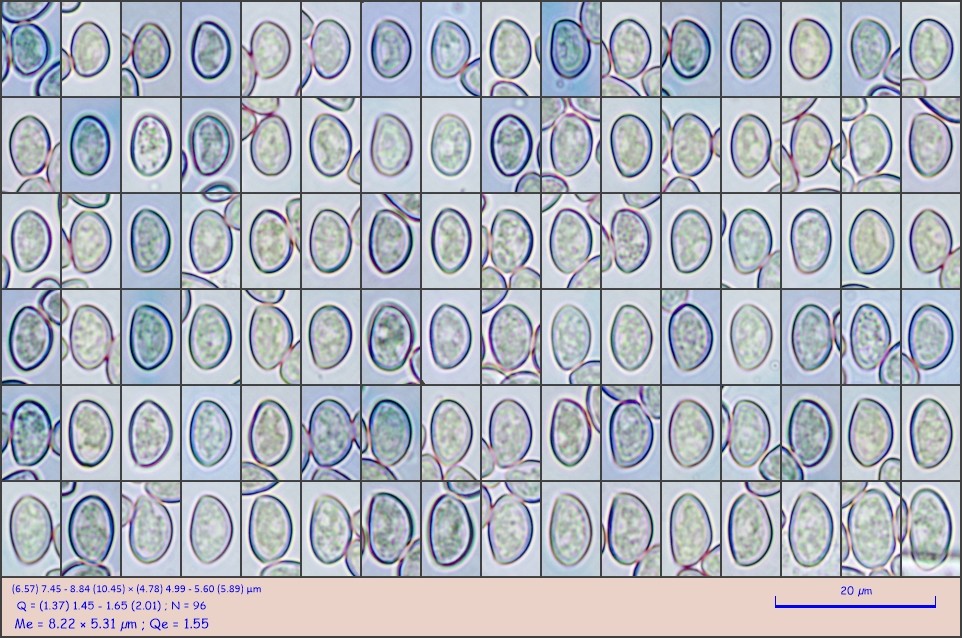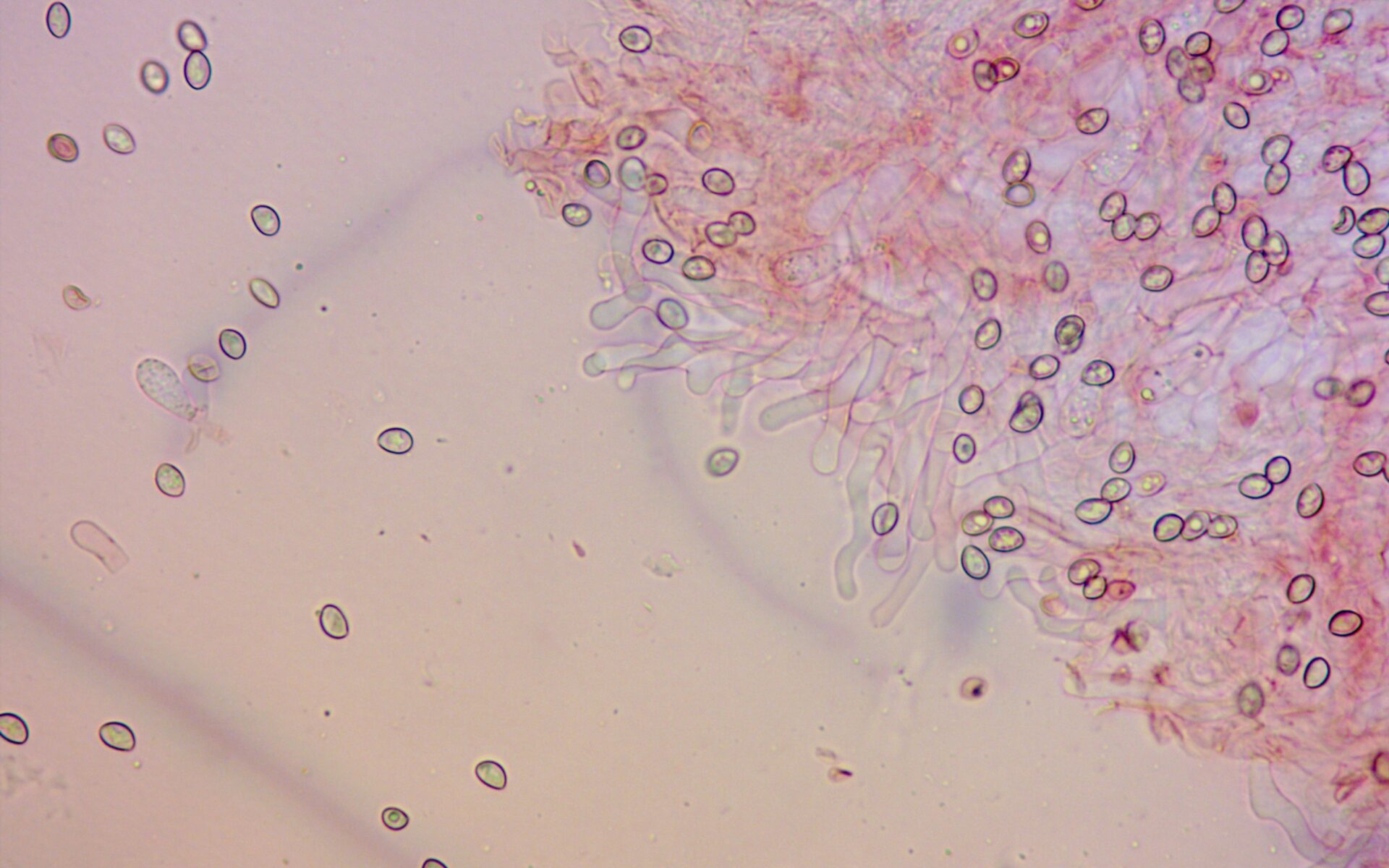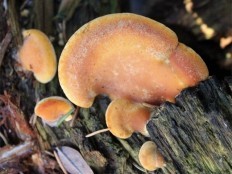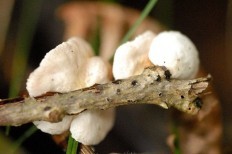tirotiro
Te crepidot ngawari (Crepidotus mollis)
- Wehenga: Basidiomycota (Basidiomycetes)
- Wehenga: Agaricomycotina (Agaricomycetes)
- Te akomanga: Agaricomycetes (Agaricomycetes)
- Te karaehe iti: Agaricomycetidae (Agaricomycetes)
- Raupapa: Agaricales (Agaric or Lamellar)
- Whānau: Inocybaceae (Fibrous)
- Roopu: Crepidotus (Крепидот)
- momo: Crepidotus mollis (crepidot ngohengohe)
- Miraka agaric Scopoli (1772)
- taiepa Agaric Scopoli (1772)
- Agaric ngawari Schaeffer (1774)
- Agaricus canescens Batsch (1783)
- Agaric gelatinous JF Gmelin (1792)
- Agaricus violaceofuvus Vahl (1792)
- Dendrosarcus alni Paulet (1808)
- He crepidopus ngawari (Schaeffer) Kerei (1821)

Ingoa tūturu Crepidotus mollis (Schaeffer) Staude (1857)
Etymology of generic and specific epithets from Crepidotus m, Crepidot. From crepis, crepidis f, hu + ούς, ωτός (ous, ōtos) n, taringa.
mollis (lat.) – ngawari, ngawari, ngawari.
Te tinana hua cap sessile, semicircular, kidney-shaped in young mushrooms in a circle, then shell-shaped fan-shaped, from pronouncedly convex to convex-prostrate, prostrate, attached sideways to the woody substrate. At the point of attachment, there is often a long-lasting rounded bulge. The edge of the cap is slightly tucked up, sometimes uneven, wavy, with age and with high humidity it can be slightly translucent. The surface is gelatinous, smooth, matte, sometimes covered with darker small sparse hairs or scales. The color of the surface is quite variable – from light yellow fawn to yellow-orange and even brown shades. No wonder the second popular name for the mushroom is chestnut crepidot. The gelatinous cuticle is elastic and separates quite easily.
Ko te rahi o te potae mai i te 0,5 ki te 5 cm, i raro i nga tikanga tipu pai ka tae ki te 7 cm.
Pulp kikokiko rapa. Tae - nga atarangi mai i te kowhai marama ki te beige, te kirīmi, kaore te tae e rereke i te waahi.
Kaore he kakara, he reka ranei. Ko etahi o nga puna korero e whakaatu ana i te ahua o te reka o muri.
Hymenophore lamellar. Ko nga pereti he ahua powhiriwhiri, he radially oriented me te piri ki te waahi o te taapiri ki te tïpako, he maha, he whaiti, he marau me te taha maeneene. He pereti poto kaore e tae ki te kakau whakapae. Ko te tae o nga pereti i roto i nga harore taitamariki he ma, he beige marama, me te pakeke, i te mea kua pakeke nga pua, ka whiwhi i te tae parauri. I roto i nga tauira tawhito rawa, tera pea he wahi whero-parauri te hymenophore i te turanga.
huha i roto i nga harore taitamariki, he iti rawa te mea timatanga, he rite te tae ki nga pereti, kua ngaro ranei.
He karu
He kōkōwhai te paura puaa, he parauri.
Poka (6,2) 7-8,5 × 4-5,3 µm, ellipsoid, paku hangarite, angiangi te pakitara, maeneene me te pakitara ahua matotoru, kowhai marama, tata kore tae, tupeka-parauri te papatipu.

Ko te Basidia 18–30 × 6–9 µm, he ahua karapu, he kowhatu kei roto ki te 30 µm te rahi, he 4-poro te nuinga, engari he rua-poroporo, kaore he awhi i te turanga.
Cheilocystidia 25 – 65 × 5 – 10 µm. porotakaroa, ahua pounamu, peeke ranei.

He mea hanga a Pileipellis e te paparanga angiangi o nga pūtau porotakaroa, i etahi wa ka paku piko.
Ko te crepidote ngohengohe he saprotroph i runga i nga kahiwi me nga rakau mate o nga rakau rau. He maha nga wa ka tupu i roto i nga roopu nui i runga i nga rakau o te maha o nga momo, tae atu ki te linden, aspen, maple, poplar, alder, beech, oak, rakau plane, he iti ake i runga i nga conifers (pine), ka whakatairanga i te hanganga o te pirau ma. I etahi wa ka tau ki runga i nga rakau ora. Ka kitea nga waahi katoa mai i Mei ki Oketopa. Te tihi hua - Hune - Mahuru. Ko te waahi tohatoha ko te rohe rangi ngawari o Uropi, Amerika Te Tai Tokerau, To tatou Whenua. Ko nga kitenga kua tuhia ki Awherika, ki Amerika ki te Tonga.
Ko te harore kai iti te uara. Ko etahi o nga puna korero e whakaatu ana i etahi rongoa rongoa, engari he maataki enei korero me te kore pono.

Te crepidot ātaahua (Crepidotus calolepis)
- i te nuinga o te waa, he tino rite, he rereke i te aroaro o nga unahi i runga i te mata o te potae, te miihini - i roto i nga puaa nui.

Te harore tio karaka (Phyllotopsis nidulans)
- ka tohuhia e te kara karaka kanapa o te potae me te kore o te gelatin-rite cuticle, me te hongi kua whakahuahia, kaore i rite ki te crepidot ngawari, kaore he kakara.

Taurangi Crepidot (Crepidotus variabilis)
- he iti ake te rahi, he iti ake nga pereti, kaore he gelatinous te mata o te potae, engari he ahua-pakeke.
- Agaricus babalinus Persoon (1828)
- Agaricus alveolus Lasch (1829)
- Pleuropus mollis (Schaeffer) Zawadzki (1835)
- Agaricus cheimonophilus Berkeley & Broome (1854)
- Crepidotus mollis (Schaeffer) Staude (1857)
- Crepidotus alveolus (Lasch) P. Kummer (1871)
- Agaricus ralfsii Berkeley & Broome (1883)
- Pikitia agaric Peck (1884)
- Crepidotus herens (Peck) Peck (1886)
- Crepidotus mollis var. pukoro (Lasch) Quélet (1886)
- Crepidotus cheimonophilus (Berkeley & Broome) Saccardo (1887)
- Crepidotus ralfsii (Berkeley & Broome) Saccardo (1887)
- Derminus mollis (Schaeffer) J. Schröter (1889)
- Derminus cheimonophilus (Berkeley & Broome) Hennings (1898)
- Derminus haerens (Peck) Hennings (1898)
- Derminus alveolus (Lasch) Hennings (1898)
- Crepidotus bubalinus (Persoon) Saccardo (1916)
- Crepidotus alabamensis Murrill (1917)
Whakaahua: Sergey.









